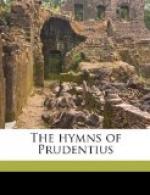Reference has already been made to the influence of Ambrose of Milan upon the thought and style of Prudentius. But there is a second and even more powerful influence that deserves at least briefly to be noted—namely, the Christian art of the Catacombs. Apart from such definite statements as e.g. are found in Peristephanon xi., it is obvious that Prudentius had a first-hand knowledge of Rome and particularly of the Catacombs. Everywhere in his poems we find evidences of the deep impression made upon his imagination by the paintings and sculptures of subterranean Rome. The now familiar representations which decorate the remains of the Catacombs suggested to him many of the allusions, the picturesque vignettes and glowing descriptions to be found in his poetry. Thus, the story of Jonah—a common theme typifying the Resurrection—the story of Daniel with its obvious consolations for an age of martyrs, the Good Shepherd and the denial of Peter may be mentioned among the numerous subjects which were reproduced in early Christian art and transferred by the poet to his verse. The symbolism of the Cock, the Dove, and the Lamb borne on the shoulders of the Good Shepherd is a perpetually recurring feature in the lyrics and martyr-hymns of Prudentius, who thus becomes one of our most valuable authorities on the Christian art of the fourth century.
The poems, of which a new English rendering is presented in this volume, are acknowledged by most critics to illustrate some of his best qualities, his brightness and dignity, his touches of nature-painting and his capacity for sustained and well-wrought narrative. As we study these lyrics of the early Church, we feel anew the mighty change that Christianity wrought in Roman life by its doctrine of immortality, and we note




